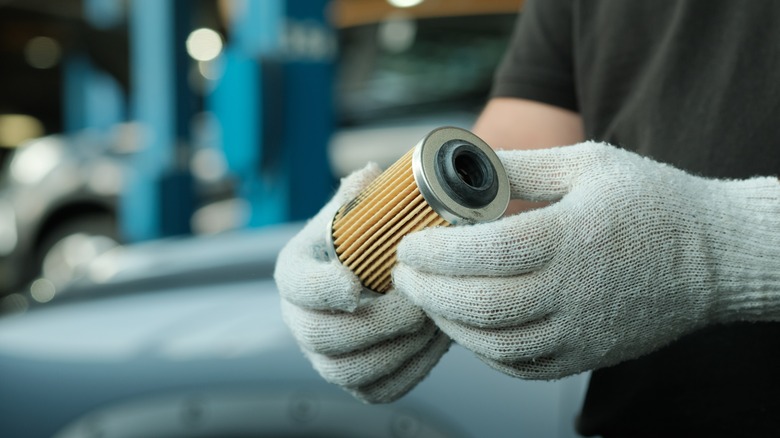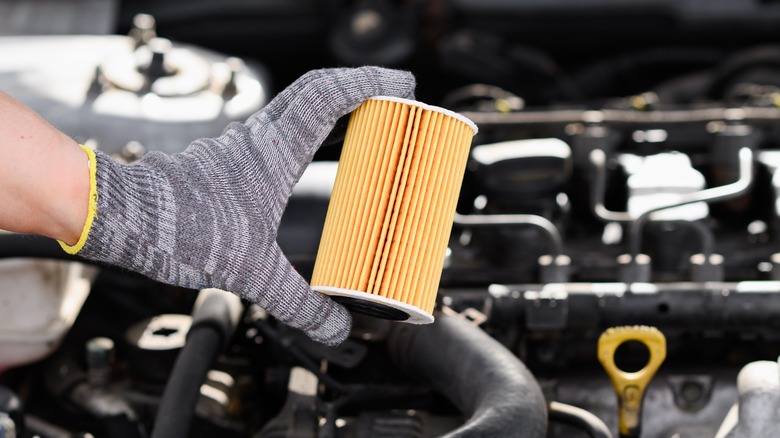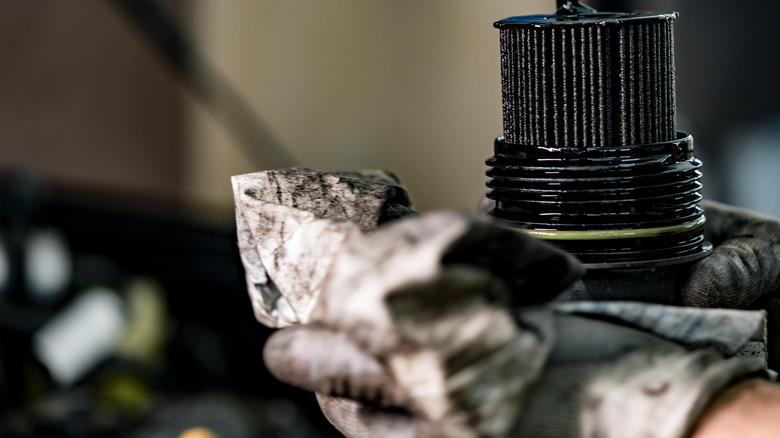Can The Wrong Oil Filter Cause Low Oil Pressure?
Whether you're changing your oil filter yourself or trying to save a little money on a quick lube shop, it's easy to assume any oil filter that's the right size for your engine will get the job done. But, as it turns out, this small part plays a huge role in the health of your engine ... and installing the wrong one can have some major consequences. One of the most serious? Low oil pressure.
This isn't just some minor performance hiccup, either: low oil pressure can spiral into major engine failure if left unchecked for too long. You see, oil pressure keeps your engine components lubricated, cool, and functioning as they should. The oil itself cuts down on the friction between your engine's moving parts and dissipates heat. Without the right pressure pushing it through the system, not even the best motor oil can do its job.
The oil filter is there to prevent contaminants. From dirt to metal shavings to byproducts of combustion, the filter grabs it all before it has a chance to re-enter the engine. At the same time, it needs to allow enough oil to pass through to maintain the proper pressure. The right size filter combined with a functioning pressure relief valve helps keep oil circulating efficiently without issue. But when the wrong oil filter is used ... the oil may leak, bypass the filter, or fail to reach key engine parts entirely.
Other risks of using the wrong oil filter
Beyond the oil pressure issue, another risks of using the wrong oil filter is a poor seal at the mounting point. Even if the filter looks like it's screwed on normally, the wrong gasket size or thread pitch can cause the filter to loosen or fall off while driving. Same goes for over- or under-tightening the oil filter.
This leads to leakage, which will gradually drain your oil levels over time (not to mention stain your driveway). As oil pressure drops, lubrication gets worse, and the engine may begin to sputter, lose acceleration, or even trigger the oil pressure warning light. In worst-case scenarios, engines run dry, overheat, and suffer from metal-on-metal grinding that can permanently damage your pistons, bearings, and camshafts.
In other cases, the issue is flow rate. Oil filters are engineered with specific flow rates depending on different engines. (For instance, a high-performance vehicle needs a filter that can handle a higher volume of oil moving at greater speeds than a standard vehicle.) Using a filter with the wrong type of flow characteristics can seriously disrupt the pressure balance. A filter with too high a flow rate might not trap all the contaminants, while one that's too restrictive can starve the engine of oil altogether. Either way, your engine oil gets dirty and can't stay clean, pressurized, and lubricated like it should.
More oil filter tips to consider
It's not just the engine that your oil filter needs to be compatible with. It also needs to work with the type of oil you're using. Some filters are only designed for use with synthetic oil or high-viscosity blends, meaning they might not perform as well with conventional motor oil. A mismatch here can make filtration even worse, disrupting the flow rate and oil pressure in the process. You don't want the kind of long-term damage that can come from this. It might not be immediately noticeable, but it will erode the engine's efficiency and lifespan over time.
While it may only seem like a small part, the oil filter's role is vital to your engine health. You have to use the one specifically designed for your vehicle's engine as recommended by the manufacturer. That includes matching the thread size, gasket diameter, height, and compatibility with your preferred oil type. Cutting corners or relying on vague aftermarket "fit-all" parts can be a dangerous gamble that just might result in thousands of dollars in engine repairs. No thanks, right?


